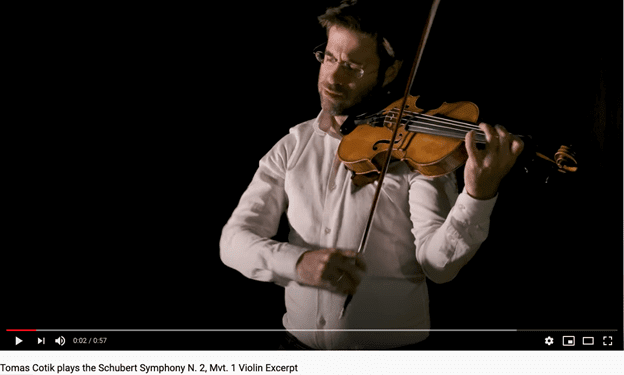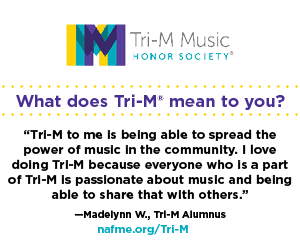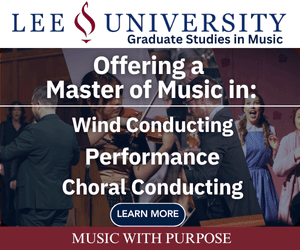NAfME BLOG
Resources for Learning the Violin Audition Excerpt: Schubert Symphony No. 2, Mvt. 1

/ News Posts / Resources for Learning the Violin Audition Excerpt: Schubert Symphony No. 2, Mvt. 1
Resources for Learning the Violin Audition Excerpt:
Schubert Symphony No. 2, Mvt. 1
By NAfME Member Tomás Cotik
Copyright © by Tomás Cotik – All rights reserved.
The April 2021 issue of Teaching Music included an article by Tomás Cotik on guidelines for recorded auditions. This is article six of six supplementing that article.
Below, you will find a brief introduction about the piece followed by a couple of recommendations of orchestral recordings and a list of concise advice that focuses on solving the usual problems that I have seen students confront in terms of rhythm, bow strokes, articulation, dynamics, vibrato, intonation, and phrasing when working on this excerpt. Please take any advice only as a guide; any recommendation or list of typical tendencies does not apply to every student. Slow, mindful practice, continued work on the basics (Intonation, Rhythm, and Sound), recording yourself regularly, and feedback from a teacher is at least as important! At the end of the document, you will find a score with the fingerings and bowings I used in the video as well as the orchestral score of the excerpt.
Watch my own video recording of this excerpt on YouTube.
Background
Schubert composed his second symphony between 1814 and 1815. The influences of Haydn, Mozart, and Beethoven can be found throughout. Beginning with a short, optimistic Largo introduction, the strings soon take off on an energetic upward flight in the Allegro vivace. This robust opening theme is based on the first theme of Beethoven’s overture to The Creatures of Prometheus. You can listen to it in this recording by the Melbourne Symphony Orchestra conducted by Michael Halasz.
Listen:
Follow along with the full score as you listen to various recordings. A few examples:
- Start with this video by Orozco-Estrada with the Frankfurt Radio Symphony.
- You can hear another version of Maazel with the Bavarian Radio Symphony Orchestra.
Rhythm:
- The tempo is fast, and the excerpt is exciting, but it does not give us the license to rush.
- Keep in mind that the violas and celli are playing steady groups of eight notes; later this is replaced by a quarter note motive and syncopations in the winds. Your melody needs to fit into this rhythmic framework perfectly.
Bow Stroke:
- Most of the time, you will need to start from the string. The beginning of each phrase needs to speak clearly. Starting from the string helps to precisely time the start of the note and to keep the bow stroke controlled and consistent. When playing with other musicians in a tutti section, it’s important to start absolutely together.
- The bow stroke can be “on-ish” or “off-ish,” as long as it is not completely off the string. The bow bounces naturally, and the stick’s flexibility is going to do the work. Only think of keeping the bow on the string in order for it to bounce. Simply guide it and allow the bow stroke to happen. This helps to precisely time the notes and keep the bow stroke controlled and consistent.
- Think about the economy of the bow: don’t use too much, even as you start practicing at a slow tempo.
- Keep the bow fingers flexible yet use concise and economic motions; avoid wobbly movements.
- The tip of your bow should draw a clean, concise path in the air (not point all over the place).
- For the ff, use more bow.
Articulation:
- Long notes should not be held too long. Keep everything articulated: You can insert a comma after the quarter notes tied to the eighth notes for clarity and articulation.
- Make sure not to swell the quarter notes slurred to the eighth notes. In fact, the energy of the Sforzandos should be stronger at the beginning of the note.
- Think “left before right”: Make sure the left finger is placed before you move your bow.
- When we think about articulation, we often focus on the start of each note. Also think of the articulation you would like at the end of each stroke.
Dynamics:
- Start the excerpt full of energy (Allegro vivace), yet pianissimo.
- Sforzandos: almost nothing and in the context of the dynamic. If you do a downbow retake, that pretty much already takes care of it.
- Prepare emotionally for the sudden dynamic changes before they happen so that you are ready for the drastic contrast.
- Maintain the pp dynamic and do not start to crescendo inadvertently.
- The first violins are in octaves with the second violins throughout the excerpt. In real life, the seconds will support the sound. (There’s no need to “shout” or over project in real life nor in the audition excerpt.)
Intonation:
- Keep the flats low.
- In 2nd and 4th position, rotate the wrist inward when needed so that 3rd and 4th fingers are not too sharp. Practice scales in different positions, maintaining the integrity of the finger shape and keeping the fingers close to the fingerboard.
- 3rd finger and “low 4” should be very close together. You might need to almost replace the 3rd finger with “low 4” to play in tune.
- Similarly, make sure that major seconds (3rd to 4th finger) are far enough apart.
- Really differentiate between tight leading notes and wide major seconds.
- There are a lot of fourths in the melody. Make sure to nail the perfect intervals.
- Understanding and hearing the harmony created by the rest of the orchestra will help you improve the intonation.
Phrasing:
- Be aware of not changing tempo with the phrasing. Keep it steady. For example, don’t rush as the melodic line goes higher.
- In measure 47, beware of accenting the third beat too much.
- Keep the sound even despite playing on different strings. For example, you will need to articulate the notes on the A string more clearly with the bow so that they speak as brilliantly and clearly as the ones on the E string.
Schubert Symphony No. 2 Mvt. 1 – Violin I
Schubert Symphony No. 2 Mvt. 1 – Score
Read parts one, two, three, four, and five.
About the author:
Hailed by Michael Tilson Thomas as “an excellent violinist,” Dr. Tomás Cotik was a first-prize winner at the National Broadcast Music Competition in his native Argentina in 1997, and the winner of the Government of Canada Award for 2003-2005. An avid recording artist, Dr. Cotik has recorded fifteen CDs for Naxos and Centaur Records, which have received enthusiastic reviews from publications such as Gramophone, Fanfare, American Record Guide, Downbeat, and MusicWeb International. Dr. Cotik was a rotating concertmaster with the New World Symphony and has performed hundreds of recitals and chamber music concerts across the globe. Committed to passing on his passion for music, Dr. Cotik was appointed Assistant Professor of Violin at Portland State University in 2016. He previously taught at West Texas A&M University, Florida International University, and at the University of Miami’s Frost School of Music. His articles about pedagogy have been published in renowned international publications such as The Strad, the American String Teacher Journal, and the American Music Teacher Journal.
E-mail: tcotik@pdx.edu
Website: www.tomascotik.com
Did this blog spur new ideas for your music program? Share them on Amplify! Interested in reprinting this article? Please review the reprint guidelines.
The National Association for Music Education (NAfME) provides a number of forums for the sharing of information and opinion, including blogs and postings on our website, articles and columns in our magazines and journals, and postings to our Amplify member portal. Unless specifically noted, the views expressed in these media do not necessarily represent the policy or views of the Association, its officers, or its employees.
March 25, 2021. © National Association for Music Education (NAfME.org)
Published Date
March 25, 2021
Category
- Ensembles
Copyright
March 25, 2021. © National Association for Music Education (NAfME.org)




